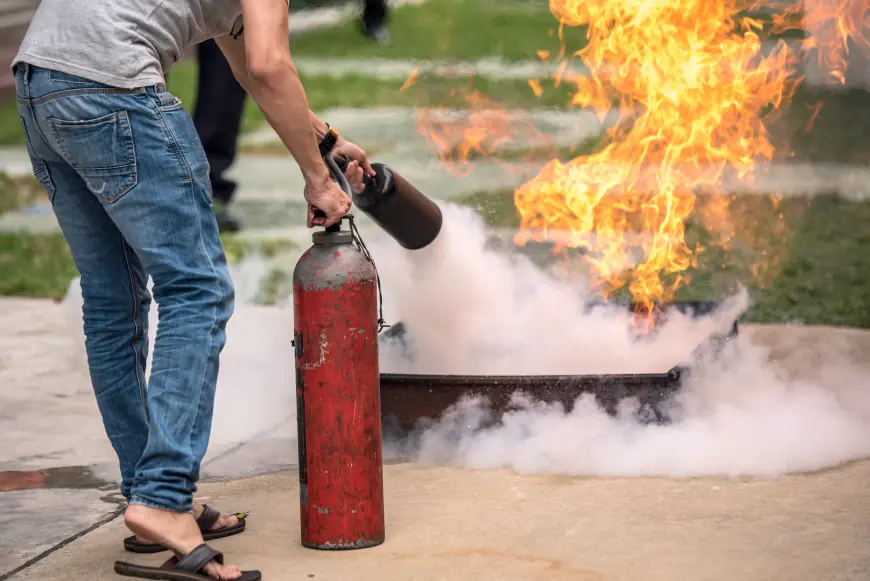Is Your Business Compliant with Australian Fire Safety Training Laws?

Is Your Business Compliant with Australian Fire Safety Training Laws?
Every Australian business, regardless of size or industry, has a legal responsibility to maintain a safe working environment for its employees and visitors. Among the various workplace safety requirements, fire safety is the most crucial. With increasing scrutiny and enforcement of fire safety legislation, ensuring your business is compliant is no longer optional; it’s essential. For those operating in high-risk zones or populated regions, such as Fire Safety Training in Sydney, compliance can also affect insurance, legal liability, and even your ability to continue operating.
But what does fire safety compliance really mean in the Australian context? And specifically, how does fire safety training fit into your legal obligations? This blog highlights these questions, outlining your responsibilities under national and state laws and offering guidance on how to remain compliant with fire safety training requirements.
Understanding Fire Safety Regulations in Australia
Australia’s fire safety framework is built on a combination of national codes and state-specific legislation. While regulations can vary between states and territories, the overarching principle is the same: businesses must identify fire hazards, implement control measures, and train staff to respond appropriately in the event of a fire.
The key legislation influencing fire safety in the workplace includes:
-
Work Health and Safety (WHS) Act and Regulations (2011)
-
Building Code of Australia (BCA)
-
Australian Standards (e.g., AS 3745-2010 for emergency planning in facilities)
These legal instruments set out what employers must do to ensure fire safety in the workplace, including risk assessment, planning, equipment maintenance, and most importantly, staff training.
Why Fire Safety Training Is a Legal Requirement
Fire safety training isn’t only a helpful precaution; it’s a legal obligation under the WHS laws. These laws require a “person conducting a business or undertaking” (PCBU) to provide relevant training and instruction to workers in managing workplace risks, including those related to fire.
According to AS 3745-2010, every workplace must develop an Emergency Plan and establish an Emergency Control Organisation (ECO). Members of the ECO, which may include fire wardens and first response personnel, must receive appropriate and regular training in emergency procedures. But training isn't only for designated personnel. All staff must receive fire safety induction training, and this must be refreshed regularly.
Failing to meet this obligation can result in penalties, ranging from fines to imprisonment in extreme cases involving negligence or injury.
Key Elements of Fire Safety Training
Fire safety training should be tailored to the specific risks and needs of your workplace. At a minimum, it should cover the following areas:
-
Fire Prevention
Training should help staff understand common fire hazards in your workplace and how to prevent them. This include safe use of electrical equipment, proper storage of flammable materials, and awareness of ignition sources.
-
Evacuation Procedures
Employees must know how to safely evacuate the building in case of fire. Training should include the location of exits, evacuation routes, assembly points, and procedures for assisting people with disabilities or special needs.
-
Use of Fire Equipment
Basic instruction on the use of fire extinguishers, fire blankets, and hose reels is essential. Staff should understand what equipment is available, how to use it, and when it’s appropriate to attempt to extinguish a fire.
-
Roles and Responsibilities
If your staff includes fire wardens or emergency response personnel, they require more in-depth training. Their roles might include coordinating evacuations, checking rooms, and liaising with emergency services.
-
Alarm and Communication Systems
Employees must be familiar with fire alarms, emergency alerts, and how to communicate during an incident. This includes using two-way radios or internal communication systems if applicable.
How Often Should Fire Safety Training Be Conducted?
Fire safety training isn’t a once-off event. The Australian Standard AS 3745-2010 recommends:
-
General staff should undergo fire safety and evacuation training at least once every 12 months
-
ECO members (such as fire wardens) should receive training every six months
In addition to formal training, businesses are expected to conduct regular fire drills, once or twice per year, to ensure that everyone knows how to act during a real emergency.
Any time a new employee joins or when changes are made to the layout of the workplace, fire safety procedures, or equipment, training must be updated accordingly.
Is Your Business Compliant?
To determine if your business is meeting its obligations, consider the following checklist:
-
Have you identified fire hazards in your workplace and developed a risk management plan?
-
Does your business have a documented and accessible Emergency Plan?
-
Have you formed an Emergency Control Organisation (ECO) with designated wardens?
-
Have all employees completed fire safety training relevant to your workplace?
-
Are you conducting fire drills regularly?
-
Are you keeping written records of all training and emergency drills?
If the answer to any of these questions is “no,” your business may not be fully compliant.
Common Mistakes That Can Lead to Non-Compliance
Many businesses unknowingly breach fire safety laws due to simple oversights. Here are a few common errors:
-
Assuming training is a one-time task, Training must be ongoing, with regular refreshers and updates.
-
Neglecting new or casual staff All workers, including part-timers and contractors, need to be trained in fire procedures.
-
Failing to maintain training records. Proof of training and drills must be documented and readily available during inspections or audits.
-
Relying solely on online modules While digital training can be convenient, it may not adequately replace hands-on fire extinguisher practice or in-person evacuation drills.
-
Not reviewing emergency plans annually. Businesses evolve, layouts change, and risks can increase. Reviewing your plan ensures it remains current.
The Role of Fire Safety in Risk Management
Beyond meeting legal obligations, investing in fire safety training is a vital part of a broader risk management strategy. It protects your assets, limits downtime, and most importantly, safeguards human lives.
Fires can have devastating consequences, not only financially, but also emotionally and reputationally. A well-trained team can respond quickly and confidently, helping prevent injury and reduce property damage in the event of an emergency.
In areas with high business density or commercial buildings, such as Fire Safety Training in Sydney, fire readiness is even more crucial due to the increased potential for damage and disruption across neighbouring properties.
Final Thoughts
Compliance with Australian fire safety training laws is not only about ticking boxes; it’s about creating a culture of safety and preparedness. Whether you operate a small office, a retail store, a warehouse, or a large commercial facility, you have a responsibility to ensure your team knows what to do in the event of a fire.
From fire prevention to evacuation, the right training empowers employees to act quickly and responsibly, saving lives and reducing damage. Regularly updated training, documented drills, and a strong safety culture will not only help your business meet its legal requirements but also build trust and resilience across your organisation.
If you're unsure where to begin, reviewing your current fire safety procedures is a good start. Ensuring your staff receive proper training in busy regions like Fire Safety Training in Sydney could be the most important step your business take this year.
What's Your Reaction?
 Like
0
Like
0
 Dislike
0
Dislike
0
 Love
0
Love
0
 Funny
0
Funny
0
 Angry
0
Angry
0
 Sad
0
Sad
0
 Wow
0
Wow
0

















































